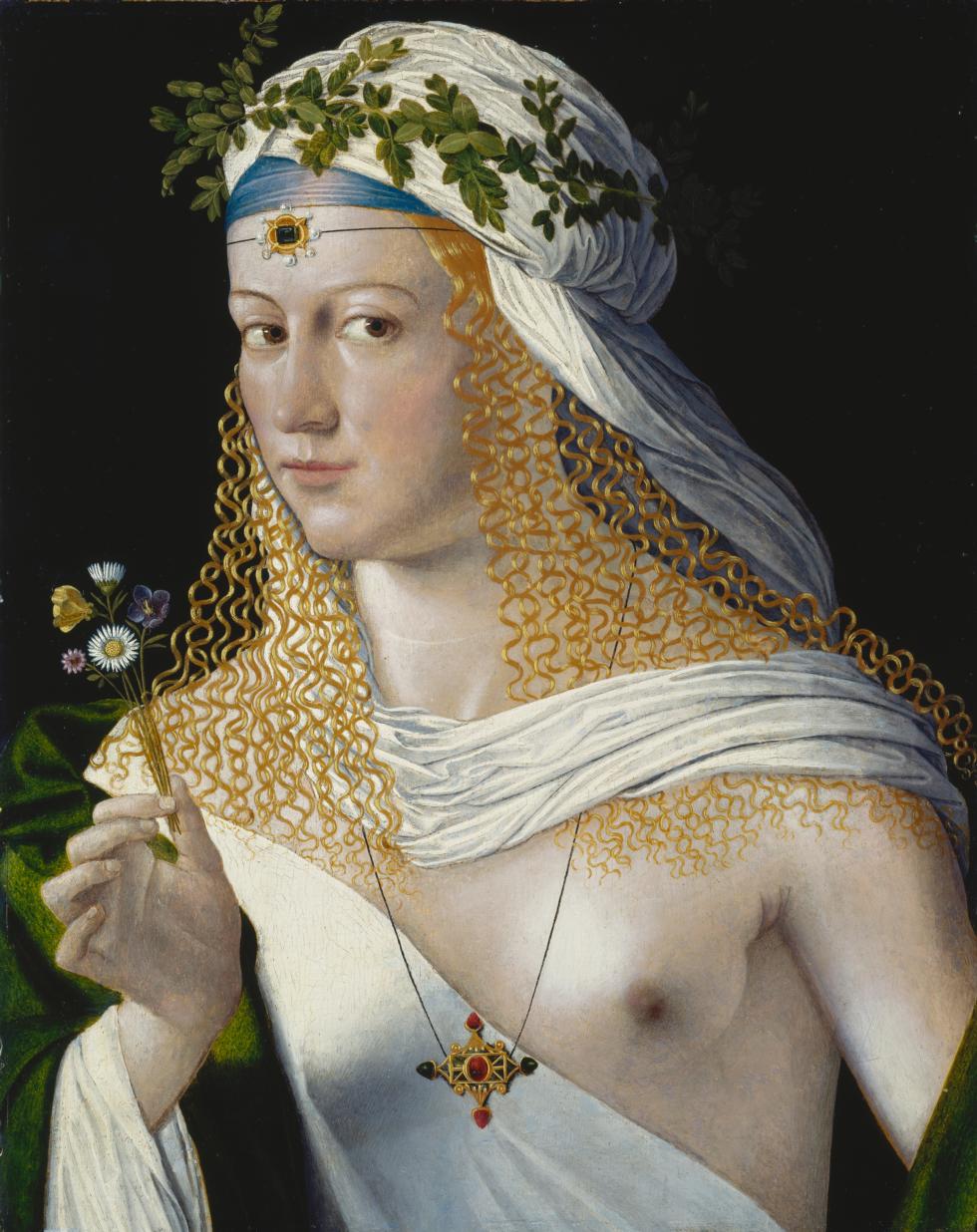 |
| Bartolomeo Veneto, A Woman as Flora, about 1505-1510. Photo: © Städel Museum–U. Edelmann–ARTOTHEK |
The Getty Museum's "The Renaissance Nude" offers an accessible premise grounded in recent scholarship. Curator Thomas Kren and colleagues orchestrated an almost unbelievable roster of loans, including major works by Donatello, Pisanello, Dieric Bouts, Jean Fouquet, Antonella da Messina, Giovanni Bellini, Luca Signorelli, Giorgione, Hans Memling, Antico, Piero di Cosimo, Lucas Cranach, Correggio, and Titian. That's just the paintings and sculptures. There are drawings by Leonardo, Michelangelo, and Raphael; prints by Schongauer, Mantegna, and Dürer; an illuminated manuscript by the Limbourg brothers. In all, it must be the biggest group of Renaissance A-listers ever shown on the West Coast. There's nothing comparable in any other U.S. museum this fall or winter. The Getty is the only American venue, and "The Renaissance Nude" travels to the Royal Academy, London, next year.
 |
| Installation view, "The Renaissance Nude" |

Jean Fouquet, Virgin and Child, about 1452-55. Image © www.lukasweb.be–Art in Flanders vzw, photo Dominique Provost
Belle Donne. The exhibition's street-banner image is Jean Fouquet's
Virgin and Child, a portrait of a royal mistress who was no virgin. Fouquet is best-known as a manuscript illuminator, and his panel paintings, such as this, are rare.
Virgin and Child is being lent by the Koninklijk Museum von Schone Kunsten, Antwerp. Its sitter, Agnes Sorel, was famed for her beauty and provocative dress. Here the biblical theme is an excuse to reveal one impossibly globular breast. No less stunning is the wallpaper pattern of 3D red and blue putti. (No 3D glasses supplied.)
Fouquet's painting created something of a scandal itself. Yet it became is a prototype for the 16th-century
belle donne: Italian portraits of beautiful woman in classical costume, with one breast bared. The semi-nudity and historical cosplay apparently made it okay for Renaissance men to display erotic pictures of their lovers.
 |
| Antonio Pollaiuolo, Battle of the Nudes, 1470s |
The Science of Nudes. Antonio Pollaiuolo must have been one of the first artists to dissect corpses in order to better draw buff arms, thighs, and six-packs. The most famous result is a pivotal Renaissance engraving,
Battle of the Nudes. Ten unclothed men battle to the death with assorted weapons. The warriors verge on being écorchés, and they seem to be paired, as if everyone is fighting the dark side of his own soul.
 |
| Leonardo da Vinci, The Superficial Anatomy of the Shoulder and Neck, about 1510-11. Image: Royal Collection Trust/© Her Majesty Queen Elizabeth II 2018, www.royalcollection.org.uk |
Pollaiuolo may have intended a scientific copybook for future artists. The scientific mission is foregrounded further in a fantastic, two-sided Leonardo drawing.
 |
| Michelangelo, Three Labors of Hercules, about 1530. Image: Royal Collection Trust/© Her Majesty Queen Elizabeth II 2018, www.royalcollection.org.uk |
The Leonardo is from the British royal collection, as are equally stupendous drawings by Michelangelo and Raphael. The show closes with a mural reproduction of Michelangelo's Sistine Chapel ceiling (1508-12), the very triumph of Renaissance nudity.
 |
| Jan Gossart, Hercules and Deianira, 1517. Image © The Henry Barber Trust, The Barber Institute of Fine Arts, University of Birmingham / Bridgeman Images |
Jan Gossart. The artist who most exceeded my expectations is the now-lesser-known Flemish painter Jan Gossart. The exhibition brings together Gossart's three great nude subjects,
Hercules and Deianira,
Venus, and
Christ on the Cold Stone. Mr. and Mrs. Hercules have a sexual and affective chemistry unlike anything else in the cold world of Renaissance love.
 |
| Cima da Conegliano, Saint Sebastian, 1500-1502. Photo: M. Bertola |
LGBT Nudes. St. Sebastian became the Christian paradigm for male-gaze-on-male erotica. There are examples here by Antonella da Messina, Jean Bourdichon, and Cima da Conegliano. Tennessee Williams adopted Sebastian as the name for his deceased sex tourist in "Suddenly Last Summer."
 |
| Hans Baldung (Grien), Two Witches, 1523. Photo: © Städel Museum–U. Edelmann–ARTOTHEK |
None of the show's artists are women. Yet there are male allusions to lesbian attraction. Hans Baldung's
The Two Witches invokes the folk tradition that witches control the weather. The humanist milieu of Baldung's Strasbourg regarded witches about as we do: as superstition suited to sitcom eroticism. Baldung's witches are as beautiful as Samantha—as queer as Endora? Don't miss the same-sex hand action in Barthel Beham's tiny engraving
Death and Three Nude Women.
The Halberdier and Pygmalion. An unexpected addition is Pontormo's
Halberdier, who is fully and fabulously clothed. It's here for a reunion with the Bronzino painting,
Pygmalion and the Statue, that was originally its cover. The two paintings were separated, and the Bronzino is now owned by the Uffizi. Pisanello's medals had popularized the idea of pairing portraits with an allegorical nude. A perhaps over-literal reading of the Bronzino cover painting is that Pontormo was in love with his painting, its subject, or both.
Nudes in Hell. Ambivalence over the pleasures of the flesh is one of the show's leitmotifs. Hieronymus Bosch was just a teenager when Dieric Bouts painted
The Fall of the Damned.
 |
| Dieric Bouts, The Fall of the Damned, 1468-69. Image © RMN-Grand Palais / Art Resource, NY. Photo: Jean-Gilles Berizzi |











Comments